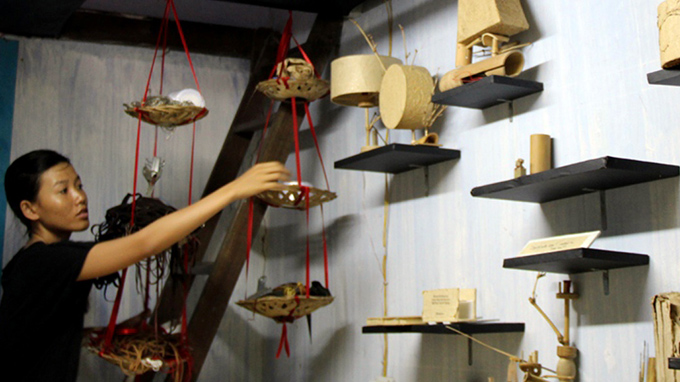“Truc chi”, which literally means bamboo and paper, a unique kind of paper made from bamboos, is the fruit of the 10-year painstaking, trial and error work by local artist Phan Hai Bang.
Bang, a lecturer at Hue Arts University, roamed across the country and traveled to Laos and Thailand for over 10 years to study paper before finally coming up with “truc chi”, or bamboo paper.
After failing again and again with different materials like straws, water-ferns, bananas and sugar cane bagasse, Bang tried his hand with bamboo and soon realized that only bamboo is fine enough to create the works he desires.
Based on the traditional process of making “giay do”, which is made from barks of “do” plants and typically used for folk paintings, especially for the country’s hallmark Dong Ho woodblocks, Bang replaced “do” with bamboo.
The bamboo paper making begins with splitting the bamboo stems into small, slim bars and soaking them in lime solution all night long before cooking and crushing them into pulp. The next step is pouring the pulp into moulds and totally drying it.
To create images and patterns on the bamboo paper, Bang has to put the images onto the paper and spray water over it before drying it. No printed images or patterns on bamboo paper are identical.
The artist then uses the paper with printed images and patterns to create a wide variety of handicraft items such as handbags, lanterns, hats, and papers for paintings and calligraphy.
Bang and his associates’ gallery, located at 4 Trieu Quang Phuc street, Hue city, showcases various bamboo paper products which take many visitors by surprise knowing that they’re all made from bamboo.
Bang has always aspired to link bamboo paper with different craft villages, such as having Bao La weaving village make bamboo frame for the paintings on bamboo paper, or printing Sinh village’s iconic paintings onto the paper instead of the conventional ‘do’ paper.
“’Truc chi’ is much more than a kind of paper, it’s in fact a blend. The challenge is how to harmoniously combine the craft villages’ uniqueness to make a gorgeous product. Such a combination will also liberate the craft villages from conventional thinking and encourage them to think outside the box and be more creative,” Bang shared.
Researcher Nguyen Dac Xuan highly appreciates bamboo paper for its wondrous fuse between the artists’ mental and hand work, between different traditional crafts, and between the traditional art values and economic benefits. The bamboo paper products appeal to a wide variety of customers and the paper allows the artists and workers to create even more new products.
“’Truc chi’ is a significant contribution to the revival of Hue traditional craft villages. Among all the research projects conducted by the Hue Arts University so far, ‘truc chi’ boasts the most applications and highest efficiency,” commented Dr. Phan Thanh Binh, principal of the Hue Arts University.



















































